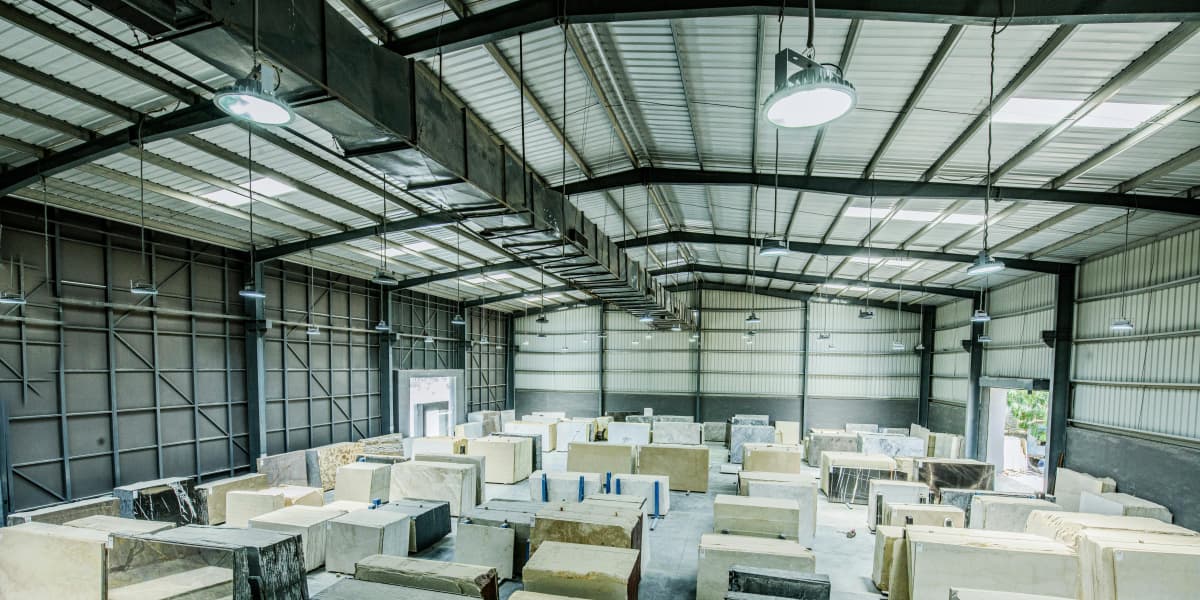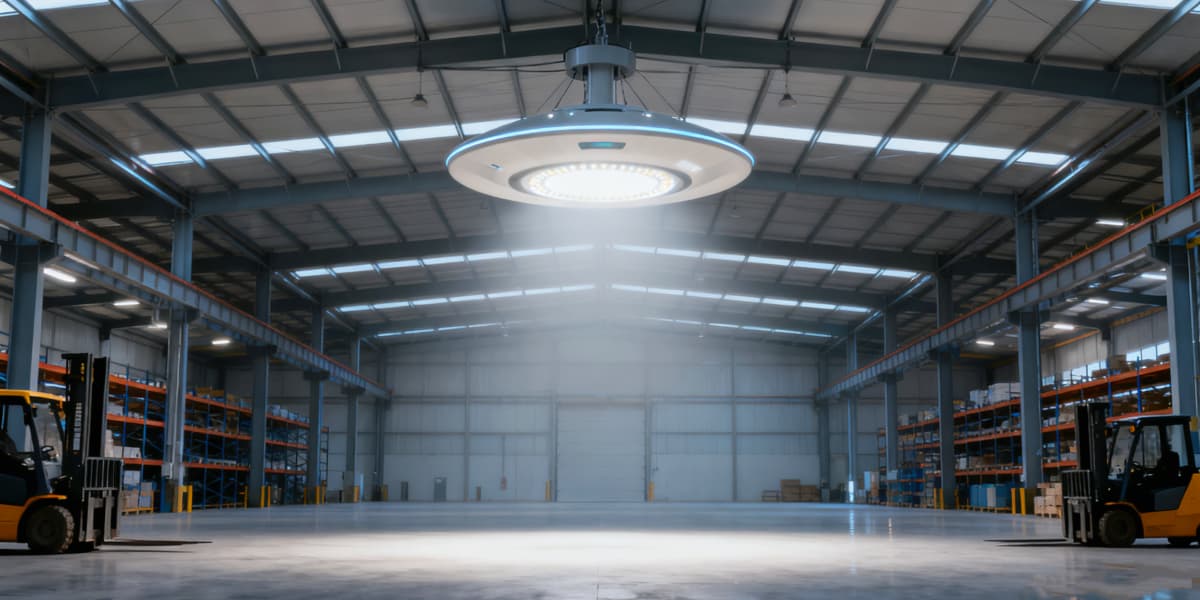LED Warehouse Lighting: The Complete Buyer’s Guide

Table of Contents
Solving Your Warehouse Lighting Problems
The Unbeatable Benefits of LED Warehouse Lighting
Types of Warehouse LED Fixtures
How to Choose & Plan Your LED Lighting for Warehouse?
Solving Your Warehouse Lighting Problems
If you’ve ever worked in a warehouse lit by old fluorescent or sodium lamps, you know the frustration — dark corners, flickering tubes, and power bills that never seem to go down. Poor lighting doesn’t just look bad; it slows people down, causes mistakes, and can even create safety hazards.
That’s why many facilities are making the switch to LED warehouse lighting — a modern, energy-saving upgrade that simply makes sense. With brighter, more consistent light and up to 70% less energy use, LEDs turn dim spaces into clean, efficient, and productive environments.
At Ceramiclite, we’ve helped countless warehouses replace outdated fixtures with advanced LED systems that deliver instant results: lower costs, better visibility, and fewer maintenance headaches. It’s not just about new lights — it’s about giving your entire facility a smarter foundation for work.
That’s why more and more businesses are moving toward LED — a safer, cleaner, and far more efficient lighting solution.
The Unbeatable Benefits of LED Warehouse Lighting
Upgrading your warehouse lighting isn’t just about getting brighter spaces — it’s about transforming how your facility works day to day. From slashing energy bills to improving worker safety, the advantages are clear and measurable.
Energy & Cost Savings
Modern LED systems use far less electricity than traditional metal halide or fluorescent lamps — up to 70% less energy in most cases. Many businesses see their overall lighting costs drop by nearly 60% within the first year.
And the savings don’t stop at utility bills. Lower heat output means less strain on your cooling systems, adding another layer of efficiency.
Saving energy isn’t just about cutting costs — it’s about freeing up your budget for smarter investments elsewhere in your operation.
Safer, More Productive Workplaces
Better lighting means better visibility. Clear, even illumination helps employees spot hazards, read labels, and navigate aisles confidently — especially in large storage areas or around forklifts.
When workers can see clearly, they make fewer mistakes and experience less fatigue. The result? Fewer accidents, smoother workflows, and a measurable boost in productivity.
Low Maintenance, Long Lifespan
LED fixtures are built to last — over 50,000 hours on average. That’s years of continuous performance without the need for constant bulb changes or downtime for maintenance.
They’re also free of mercury and other pollutants, making them safer for your team and the environment. With fewer replacements and less waste, you save both time and labor while supporting sustainable practices.
Investing in high-quality industrial LED lighting turns your warehouse into a cleaner, safer, and more cost-efficient operation — one that’s built to perform reliably for years to come.
Types of Warehouse LED Fixtures
Every warehouse is different — ceiling heights, layouts, and work zones all require the right lighting design. Below is your quick guide to the main types of LED fixtures used in modern warehouses, along with where and why each one works best.
High Bay LED Lights
Best for: Ceilings above 20 feet (6 m) — common in large storage halls or manufacturing areas.
(1) Round High Bay Lights
Also known as UFO LED high bay lights, these are compact, powerful, and ideal for open spaces. Their circular beam spreads evenly across wide areas, providing bright, uniform illumination.

(2) Linear High Bay Lights
Shaped like long panels, they fit perfectly between warehouse racking. The linear beam pattern helps light up aisles evenly without glare or shadows.

Typical mounting height: 20–40 ft (6–12 m) depending on lumen output.
Low Bay LED Lights
Best for: Ceilings below 20 feet (6 m), such as packing zones, workshops, or loading docks.
(1) Round Low Bay Lights
Compact and versatile, perfect for open workstations or areas that need broad light coverage.

(2) Linear Low Bay Lights
Slim, rectangular fixtures that create even light over tables and shelves — excellent for precision work or inspection zones.

Typical mounting height: 10–20 ft (3–6 m) for balanced brightness and comfort.
LED Tube Lights
A direct upgrade from traditional fluorescent tubes. They’re ideal for corridors, small storage rooms, or maintenance areas.
Easy to install and energy-efficient, they offer consistent brightness without flickering or warm-up time.
Wall Packs
Used on interior or exterior walls, wall packs add extra visibility near entrances, exits, or loading docks. They enhance safety for both people and vehicles, especially in after-hours operations.
LED Emergency Lights & Exit Signs
These are essential safety fixtures that remain lit during power outages. They guide staff safely to exits and comply with fire and building codes.
Compact, durable, and battery-backed, they’re small but vital components of every warehouse lighting plan.
Choosing the right mix of fixtures ensures your facility is bright, compliant, and energy-efficient from floor to ceiling. Each type serves a purpose — together, they create a complete, reliable lighting ecosystem built for productivity and safety.
How to Choose & Plan Your LED Lighting for Warehouse?
Designing the right lighting system isn’t just about buying bright fixtures — it’s about balancing efficiency, safety, and visual comfort.
Here’s a simple, step-by-step guide to help you plan your warehouse LED lighting like a pro.
Step 1: Master the Key Specifications
1. Lumens, Not Watts
Forget watts — lumens measure actual light output.
A 100W LED light can produce 13,000–15,000 lumens, far brighter and more efficient than old metal halides.
Quick Lumen Reference Table:
Ceiling Height | Area Type | Recommended Lumens per Fixture |
10–15 ft | Packing / Sorting | 10,000–15,000 lm |
16–25 ft | Medium Storage | 16,000–20,000 lm |
26–35 ft | Large Warehouse | 22,000–30,000 lm |
36–45 ft | High Bay / Industrial | 30,000–40,000+ lm |
Rule of thumb: The higher the ceiling, the higher the lumens — but balance brightness to avoid glare.
2. Color Temperature (CCT)
Color temperature defines how “warm” or “cool” light feels:
4000K (Neutral White): Balanced brightness, ideal for general storage areas.
5000K (Cool White): Crisp daylight tone, improves alertness and visibility — perfect for logistics and production zones.
Most warehouses use 4000K–5000K for optimal performance.
3. Beam Angle
Think of the beam angle as how widely light spreads:
Narrow beam (60°–90°): Focused illumination for tall racks or spot lighting.
Wide beam (120°–150°): Broader coverage for open floor areas.
Visual tip: Narrow beams cut through high ceilings; wide beams fill large open spaces evenly.
4. CRI & IP Rating
CRI (Color Rendering Index): Aim for CRI ≥ 80 so workers can distinguish labels, wires, and products accurately.
IP Rating:
IP65 or higher for dusty or damp environments.
IP40–54 for clean indoor areas.
These specs ensure both color accuracy and fixture longevity.
Step 2: Plan Your Layout for Compliance & Efficiency
A well-planned layout ensures you meet safety standards and reduce energy waste.
1. Foot-Candles and Lux Explained
Foot-candle (fc): Light level measured in lumens per square foot.
Lux: Lumens per square meter. (1 fc ≈ 10.76 lux)
OSHA / Industry Recommendations:
Warehouse Area | Recommended Illumination |
Bulk Storage | 10–20 fc (≈100–200 lux) |
Active Aisles / Shelving | 20–50 fc (≈200–500 lux) |
Loading Docks | 30–50 fc |
Inspection / Workstations | 50–70 fc |
Meeting these levels helps you stay OSHA-compliant and ensures workers can operate safely.
2. The Calculation Guide
You don’t need advanced software — here’s a simple formula to estimate:
Number of Fixtures = (Area × Required Lux) ÷ (Fixture Lumens × Utilization Factor × Maintenance Factor)
For example:
Warehouse area: 1,000 m²
Required lux: 300
Fixture lumens: 20,000
Utilization × Maintenance = 0.8 × 0.9 = 0.72
Result: (1,000 × 300) ÷ (20,000 × 0.72) ≈ 21 fixtures
Or use a free online lighting calculator — many reliable ones allow you to input room size and mounting height for a quick estimate.
Step 3: Select the Right Mounting Option
Different ceiling heights and layouts call for different mounting styles.
Mounting Type | Ideal Ceiling Height | Best For | Advantages |
Direct Mount | 10–20 ft | Low bays / small warehouses | Sleek, space-saving |
Pendant Mount | 25–40 ft | High ceilings / open bays | Adjustable height, even coverage |
Chain Mount | 15–30 ft | Retrofit projects | Easy to install & maintain |
Hook Mount (UFO style) | 20–45 ft | Large industrial zones | Quick installation, flexible placement |
Tip: Use pendant or hook mounts for high ceilings, and direct mounts for tighter spaces where every inch matters.
✅ Pro Planning Checklist
Before you finalize your lighting plan:
![]() Measure your ceiling height & total area
Measure your ceiling height & total area
![]() Choose lumens & beam angles based on height
Choose lumens & beam angles based on height
![]() Match CCT to work zone type (4000K–5000K)
Match CCT to work zone type (4000K–5000K)
![]() Check OSHA brightness levels (foot-candles)
Check OSHA brightness levels (foot-candles)
![]() Select mounting options for safety & ease
Select mounting options for safety & ease
In short:
A smart lighting plan balances brightness, efficiency, and compliance.
Once you master the specs, layout, and mounting, your warehouse will not only look better — it’ll work better.
Conclusion
Switching to LED warehouse lighting isn’t just an upgrade — it’s a transformation.
It means better visibility, higher safety, lower energy bills, and a cleaner, more productive environment for everyone on the floor.
Modern LEDs have reshaped how warehouses operate.
From motion sensors that cut unnecessary power use to high-efficiency optics that reduce glare and improve accuracy — every detail now contributes to smarter, more sustainable operations.
If you’ve followed this guide, you now understand how to:
Choose the right lumen level and color temperature
Plan lighting layouts that meet OSHA standards
Pick mounting options that fit your ceiling height and workflow
Each of these steps helps you create a brighter, safer, and more cost-effective workspace.
Hope this guide has been helpful.
And if you’re ready to take the next step — why not start today?
Ready to transform your warehouse lighting and start saving?
Ceramiclite’s professional industrial lighting solutions are trusted by factories, fulfillment centers, and logistics hubs across Europe and the U.S.
Choose performance, reliability, and design expertise — choose Ceramiclite LED warehouse lighting.
Frequently Asked Questions
Q1: What is the best color temperature for warehouse lighting?
Most warehouses use 4000K to 5000K lighting.
4000K gives a neutral white tone suitable for general areas, while 5000K provides bright daylight-style light that enhances focus and visibility.
See the full explanation in Step 1: Color Temperature (CCT) above.
Q2: How many lights do I need for a 10,000 sq ft warehouse?
It depends on ceiling height, lumen output per fixture, and desired brightness level.
As a general rule, a 10,000 sq ft space typically needs 20–30 high bay fixtures rated around 20,000–25,000 lumens each to achieve proper visibility.
You can use an online lighting calculator or contact our team for a free layout plan.
Q3: Can I replace metal halide fixtures with LED?
Absolutely.
LEDs are direct replacements for metal halide, fluorescent, and HPS lamps — offering up to 70% energy savings and instant full brightness.
They also last 5–10 times longer, reducing both downtime and maintenance costs.
Q4: What’s the average ROI period for an LED warehouse lighting upgrade?
Most facilities see a return on investment within 12 to 18 months through energy savings and lower maintenance.
With rebates and long lifespans, LEDs continue to save money for years beyond that.
Q5: How do I dispose of old warehouse lighting fixtures?
If you’re replacing fluorescent or metal halide lamps, don’t throw them in regular trash — they often contain mercury or other hazardous materials.
Contact a local recycling center or hazardous waste facility for proper disposal.
LEDs, by contrast, are mercury-free and environmentally safe to recycle.
Q6: Do LED lights work well in cold warehouse environments?
Yes.
LEDs actually perform better in cold temperatures, making them perfect for cold storage or refrigerated facilities where traditional lights struggle to start or dim.
Q7: Are LED warehouse lights dimmable or motion-sensor compatible?
Most modern LED fixtures support 0–10V dimming and can be paired with motion or daylight sensors for automatic control.
This helps save even more on energy while maintaining consistent light levels.
If you have more questions or need help planning your upgrade, our lighting experts are happy to assist.
Contact Ceramiclite for a free consultation and custom warehouse lighting design.
_thumb.jpg)
